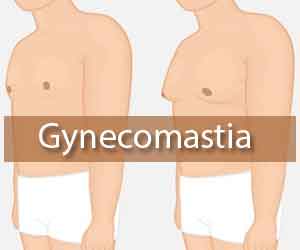- Home
- Editorial
- News
- Practice Guidelines
- Anesthesiology Guidelines
- Cancer Guidelines
- Cardiac Sciences Guidelines
- Critical Care Guidelines
- Dentistry Guidelines
- Dermatology Guidelines
- Diabetes and Endo Guidelines
- Diagnostics Guidelines
- ENT Guidelines
- Featured Practice Guidelines
- Gastroenterology Guidelines
- Geriatrics Guidelines
- Medicine Guidelines
- Nephrology Guidelines
- Neurosciences Guidelines
- Obs and Gynae Guidelines
- Ophthalmology Guidelines
- Orthopaedics Guidelines
- Paediatrics Guidelines
- Psychiatry Guidelines
- Pulmonology Guidelines
- Radiology Guidelines
- Surgery Guidelines
- Urology Guidelines
Gynecomastia evaluation and management- EAA clinical practice guidelines

American Society of Andrology and European Academy of Andrology have released guidelines on gynecomastia evaluation and management. The guidelines have been published in the Journal Andrology.
Gynacomastia (GM) is a benign proliferation of the glandular tissue of the breast in men. It is a frequent condition with a reported prevalence of 32–65%, depending on the age and the criteria used for definition. GM of infancy and puberty are common, benign conditions resolving spontaneously in the majority of cases. GM of adulthood is more prevalent among the elderly and proper investigation may reveal an underlying pathology in 45–50% of cases.
A set of five statements and fifteen clinical recommendations was formulated.
The purpose of GM assessment should be the detection of underlying pathological conditions, reversible causes and the discrimination from other breast lumps, particularly breast cancer. The assessments should comprise a thorough medical history and physical examination of the breast and genitalia (including testicular ultrasound). A set of laboratory investigations may integrate the evaluation: testosterone (T), estradiol (E2), sex hormone‐binding globulin (SHBG), luteinizing hormone (LH), follicular stimulating hormone (FSH), thyroid-stimulating hormone (TSH), prolactin, human chorionic gonadotropin (hCG), alpha‐fetal protein (AFP), liver and renal function tests. Breast imaging may be used whenever the clinical examination is equivocal. In suspicious lesions, core needle biopsy should be sought directly instead. Watchful waiting is recommended after treatment of underlying pathology or discontinuation of substances associated with GM. T treatment should be offered to men with proven T deficiency. The use of selective estrogen receptor modulators (SERMs), aromatase inhibitors (AIs) and non‐aromatizable androgens is not justified in general. Surgical treatment is the therapy of choice for patients with long‐lasting GM.
Following are the major recommendations:
- The presence of an underlying pathology should be considered in GM of adulthood. We recommend that the identification of an apparent reason for GM in adulthood, including the use of medication known to be associated with GM, should not preclude a detailed investigation.
- We suggest that the initial screening to rule out lipomastia, obvious breast cancer, or testicular cancer might be performed by a general practitioner or another non‐specialist.
- We recommend that in those cases where a thorough diagnostic workup is warranted, it should be performed by a specialist.
- We recommend that the medical history should include information on the onset and duration of GM, sexual development and function, and administration or abuse of substances associated with GM.
- We recommend that the physical examination should detect signs of under‐virilization or systemic disease.
- We recommend that breast examination should confirm the presence of palpable glandular tissue to discriminate GM from lipomastia (pseudo‐gynecomastia) and rule out the suspicion of malignant breast tumor.
- We recommend that the physical examination should include the examination of the genitalia to rule out the presence of a palpable testicular tumor and to detect testicular atrophy.
- We recommend that genitalia examination is aided by a testicular ultrasound, as the detection of a testicular tumor by palpation has low sensitivity.
- We suggest that a set of evaluations may include T, E2, SHBG, LH, FSH, TSH, prolactin, hCG, AFP, and liver and renal function tests.
- We suggest that breast imaging may offer assistance, where the clinical examination is equivocal.
- We suggest that, if the clinical picture is suspicious for a malignant lesion, core needle biopsy should be performed.
- We recommend watchful waiting after treatment of underlying pathology or discontinuation of the administration/abuse of substances associated with GM.
- We recommend that T treatment should be offered only to men with proven testosterone deficiency.
- We do not recommend the use of selective estrogen receptor modulators (SERMs), aromatase inhibitors (AIs), or non‐aromatizable androgens in the treatment of GM in general.
- We suggest surgical treatment only for patients with long‐lasting GM, which does not regress spontaneously or following medical therapy. The extent and type of surgery depend on the size of breast enlargement, and the amount of adipose tissue.
For more details click on the link: https://doi.org/10.1111/andr.12636

Disclaimer: This site is primarily intended for healthcare professionals. Any content/information on this website does not replace the advice of medical and/or health professionals and should not be construed as medical/diagnostic advice/endorsement or prescription. Use of this site is subject to our terms of use, privacy policy, advertisement policy. © 2020 Minerva Medical Treatment Pvt Ltd